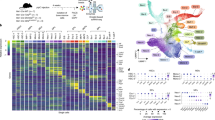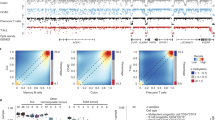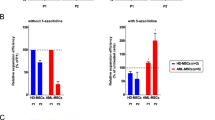Abstract
The DNA hypomethylating drug decitabine maintains normal hematopoietic stem cell (HSC) self-renewal but induces terminal differentiation in acute myeloid leukemia (AML) cells. The basis for these contrasting cell fates, and for selective CpG hypomethylation by decitabine, is poorly understood. Promoter CpGs, with methylation measured by microarray, were classified by the direction of methylation change with normal myeloid maturation. In AML cells, the methylation pattern at maturation-responsive CpGs suggested at least partial maturation. Consistent with partial maturation, in gene expression analyses, AML cells expressed high levels of the key lineage-specifying factor CEBPA, but relatively low levels of the key late-differentiation driver CEBPE. In methylation analysis by mass spectrometry, CEBPE promoter CpGs that are usually hypomethylated during granulocyte maturation were significantly hypermethylated in AML cells. Decitabine-induced hypomethylation was greatest at these and other promoter CpGs that are usually hypomethylated with myeloid maturation, accompanied by cellular differentiation of AML cells. In contrast, decitabine-treated normal HSCs retained immature morphology, and methylation significantly decreased at CpGs that are less methylated in immature cells. High expression of lineage-specifying factor and aberrant epigenetic repression of some key late-differentiation driver genes distinguishes AML cells from normal HSCs, and could explain the contrasting differentiation and methylation responses to decitabine.
This is a preview of subscription content, access via your institution
Access options
Subscribe to this journal
Receive 12 print issues and online access
$259.00 per year
only $21.58 per issue
Buy this article
- Purchase on Springer Link
- Instant access to full article PDF
Prices may be subject to local taxes which are calculated during checkout







Similar content being viewed by others
References
Santi DV, Garrett CE, Barr PJ . On the mechanism of inhibition of DNA-cytosine methyltransferases by cytosine analogs. Cell 1983; 33: 9–10.
Covey JM, D'Incalci M, Tilchen EJ, Zaharko DS, Kohn KW . Differences in DNA damage produced by incorporation of 5-aza-2′-deoxycytidine or 5,6-dihydro-5-azacytidine into DNA of mammalian cells. Cancer Res 1986; 46: 5511–5517.
Schermelleh L, Haemmer A, Spada F, Rosing N, Meilinger D, Rothbauer U et al. Dynamics of Dnmt1 interaction with the replication machinery and its role in postreplicative maintenance of DNA methylation. Nucleic Acids Res 2007; 35: 4301–4312.
Momparler RL, Goodman J . In vitro cytotoxic and biochemical effects of 5-aza-2′-deoxycytidine. Cancer Res 1977; 37: 1636–1639.
Jones PA, Taylor SM . Cellular differentiation, cytidine analogs and DNA methylation. Cell 1980; 20: 85–93.
Milhem M, Mahmud N, Lavelle D, Araki H, Desimone J, Saunthararajah Y et al. Modification of hematopoietic stem cell fate by 5aza 2′deoxycytidine and trichostatin A. Blood 2004; 103: 4102–4110.
Bug G, Gul H, Schwarz K, Pfeifer H, Kampfmann M, Zheng X et al. Valproic acid stimulates proliferation and self-renewal of hematopoietic stem cells. Cancer Res 2005; 65: 2537–2541.
Young JC, Wu S, Hansteen G, Du C, Sambucetti L, Remiszewski S et al. Inhibitors of histone deacetylases promote hematopoietic stem cell self-renewal. Cytotherapy 2004; 6: 328–336.
Araki H, Yoshinaga K, Boccuni P, Zhao Y, Hoffman R, Mahmud N . Chromatin-modifying agents permit human hematopoietic stem cells to undergo multiple cell divisions while retaining their repopulating potential. Blood 2007; 109: 3570–3578.
De Felice L, Tatarelli C, Mascolo MG, Gregorj C, Agostini F, Fiorini R et al. Histone deacetylase inhibitor valproic acid enhances the cytokine-induced expansion of human hematopoietic stem cells. Cancer Res 2005; 65: 1505–1513.
Hu Z, Negrotto S, Gu X, Mahfouz R, Ng KP, Ebrahem Q et al. Decitabine maintains hematopoietic precursor self-renewal by preventing repression of stem cell genes by a differentiation-inducing stimulus. Mol Cancer Ther 2010; 9: 1536–1543.
Chung YS, Kim HJ, Kim TM, Hong SH, Kwon KR, An S et al. Undifferentiated hematopoietic cells are characterized by a genome-wide undermethylation dip around the transcription start site and a hierarchical epigenetic plasticity. Blood 2009; 114: 4968–4978.
Suzuki M, Harashima A, Okochi A, Yamamoto M, Nakamura S, Motoda R et al. 5-Azacytidine supports the long-term repopulating activity of cord blood CD34(+) cells. Am J Hematol 2004; 77: 313–315.
Broske AM, Vockentanz L, Kharazi S, Huska MR, Mancini E, Scheller M et al. DNA methylation protects hematopoietic stem cell multipotency from myeloerythroid restriction. Nat Genet 2009; 41: 1207–1215.
Trowbridge JJ, Snow JW, Kim J, Orkin SH . DNA methyltransferase 1 is essential for and uniquely regulates hematopoietic stem and progenitor cells. Cell Stem Cell 2009; 5: 442–449.
Pinto A, Attadia V, Fusco A, Ferrara F, Spada OA, Di Fiore PP . 5-Aza-2′-deoxycytidine induces terminal differentiation of leukemic blasts from patients with acute myeloid leukemias. Blood 1984; 64: 922–929.
Creusot F, Acs G, Christman JK . Inhibition of DNA methyltransferase and induction of Friend erythroleukemia cell differentiation by 5-azacytidine and 5-aza-2′-deoxycytidine. J Biol Chem 1982; 257: 2041–2048.
Nowak D, Stewart D, Koeffler HP . Differentiation therapy of leukemia: 3 decades of development. Blood 2009; 113: 3655–3665.
Niitsu N, Hayashi Y, Sugita K, Honma Y . Sensitization by 5-aza-2′-deoxycytidine of leukaemia cells with MLL abnormalities to induction of differentiation by all-trans retinoic acid and 1alpha,25-dihydroxyvitamin D3. Br J Haematol 2001; 112: 315–326.
Kosugi H, Towatari M, Hatano S, Kitamura K, Kiyoi H, Kinoshita T et al. Histone deacetylase inhibitors are the potent inducer/enhancer of differentiation in acute myeloid leukemia: a new approach to anti-leukemia therapy. Leukemia 1999; 13: 1316–1324.
Wang J, Saunthararajah Y, Redner RL, Liu JM . Inhibitors of histone deacetylase relieve ETO-mediated repression and induce differentiation of AML1-ETO leukemia cells. Cancer Res 1999; 59: 2766–2769.
Spira AI, Carducci MA . Differentiation therapy. Curr Opin Pharmacol 2003; 3: 338–343.
Jones PA . DNA methylation and cancer. Cancer Res 1986; 46: 461–466.
Lotem J, Sachs L . Epigenetics wins over genetics: induction of differentiation in tumor cells. Semin Cancer Biol 2002; 12: 339–346.
Attema JL, Papathanasiou P, Forsberg EC, Xu J, Smale ST, Weissman IL . Epigenetic characterization of hematopoietic stem cell differentiation using miniChIP and bisulfite sequencing analysis. Proc Natl Acad Sci USA 2007; 104: 12371–12376.
Jiang Y, Dunbar A, Gondek LP, Mohan S, Rataul M, O'Keefe C et al. Aberrant DNA methylation is a dominant mechanism in MDS progression to AML. Blood 2009; 113: 1315–1325.
Mulloy JC, Cammenga J, MacKenzie KL, Berguido FJ, Moore MA, Nimer SD . The AML1-ETO fusion protein promotes the expansion of human hematopoietic stem cells. Blood 2002; 99: 15–23.
Bibikova M, Lin Z, Zhou L, Chudin E, Garcia EW, Wu B et al. High-throughput DNA methylation profiling using universal bead arrays. Genome Res 2006; 16: 383–393.
Ehrich M, Nelson MR, Stanssens P, Zabeau M, Liloglou T, Xinarianos G et al. Quantitative high-throughput analysis of DNA methylation patterns by base-specific cleavage and mass spectrometry. Proc Natl Acad Sci USA 2005; 102: 15785–15790.
Heinemeyer T, Wingender E, Reuter I, Hermjakob H, Kel AE, Kel OV et al. Databases on transcriptional regulation: TRANSFAC, TRRD and COMPEL. Nucleic Acids Res 1998; 26: 362–367.
Martin-Subero JI, Ammerpohl O, Bibikova M, Wickham-Garcia E, Agirre X, Alvarez S et al. A comprehensive microarray-based DNA methylation study of 367 hematological neoplasms. PLoS ONE 2009; 4: e6986.
Iwasaki H, Akashi K . Myeloid lineage commitment from the hematopoietic stem cell. Immunity 2007; 26: 726–740.
Yamanaka R, Barlow C, Lekstrom-Himes J, Castilla LH, Liu PP, Eckhaus M et al. Impaired granulopoiesis, myelodysplasia, and early lethality in CCAAT/enhancer binding protein epsilon-deficient mice. Proc Natl Acad Sci USA 1997; 94: 13187–13192.
Theilgaard-Monch K, Jacobsen LC, Borup R, Rasmussen T, Bjerregaard MD, Nielsen FC et al. The transcriptional program of terminal granulocytic differentiation. Blood 2005; 105: 1785–1796.
Stirewalt DL, Meshinchi S, Kopecky KJ, Fan W, Pogosova-Agadjanyan EL, Engel JH et al. Identification of genes with abnormal expression changes in acute myeloid leukemia. Genes Chromosomes Cancer 2008; 47: 8–20.
Ferrari F, Bortoluzzi S, Coppe A, Basso D, Bicciato S, Zini R et al. Genomic expression during human myelopoiesis. BMC Genomics 2007; 8: 264.
Valk PJ, Verhaak RG, Beijen MA, Erpelinck CA, Barjesteh van Waalwijk van Doorn-Khosrovani S, Boer JM et al. Prognostically useful gene-expression profiles in acute myeloid leukemia. N Engl J Med 2004; 350: 1617–1628.
Cheung AM, Chow HC, Liang R, Leung AY . A comparative study of bone marrow and peripheral blood CD34+ myeloblasts in acute myeloid leukaemia. Br J Haematol 2009; 144: 484–491.
Pellagatti A, Cazzola M, Giagounidis AA, Malcovati L, Porta MG, Killick S et al. Gene expression profiles of CD34+ cells in myelodysplastic syndromes: involvement of interferon-stimulated genes and correlation to FAB subtype and karyotype. Blood 2006; 108: 337–345.
Majeti R, Becker MW, Tian Q, Lee TL, Yan X, Liu R et al. Dysregulated gene expression networks in human acute myelogenous leukemia stem cells. Proc Natl Acad Sci USA 2009; 106: 3396–3401.
Nakajima H, Ihle JN . Granulocyte colony-stimulating factor regulates myeloid differentiation through CCAAT/enhancer-binding protein epsilon. Blood 2001; 98: 897–905.
Taussig DC, Miraki-Moud F, Anjos-Afonso F, Pearce DJ, Allen K, Ridler C et al. Anti-CD38 antibody-mediated clearance of human repopulating cells masks the heterogeneity of leukemia-initiating cells. Blood 2008; 112: 568–575.
Kirstetter P, Schuster MB, Bereshchenko O, Moore S, Dvinge H, Kurz E et al. Modeling of C/EBPalpha mutant acute myeloid leukemia reveals a common expression signature of committed myeloid leukemia-initiating cells. Cancer Cell 2008; 13: 299–310.
Huntly BJ, Shigematsu H, Deguchi K, Lee BH, Mizuno S, Duclos N et al. MOZ-TIF2, but not BCR-ABL, confers properties of leukemic stem cells to committed murine hematopoietic progenitors. Cancer Cell 2004; 6: 587–596.
Somervaille TC, Cleary ML . Identification and characterization of leukemia stem cells in murine MLL-AF9 acute myeloid leukemia. Cancer Cell 2006; 10: 257–268.
van Rhenen A, Moshaver B, Kelder A, Feller N, Nieuwint AW, Zweegman S et al. Aberrant marker expression patterns on the CD34+. Leukemia 2007; 21: 1700–1707.
Blair A, Hogge DE, Ailles LE, Lansdorp PM, Sutherland HJ . Lack of expression of Thy-1 (CD90) on acute myeloid leukemia cells with long-term proliferative ability in vitro and in vivo. Blood 1997; 89: 3104–3112.
Blair A, Sutherland HJ . Primitive acute myeloid leukemia cells with long-term proliferative ability in vitro and in vivo lack surface expression of c-kit (CD117). Exp Hematol 2000; 28: 660–671.
Wunderlich M, Chou FS, Link KA, Mizukawa B, Perry RL, Carroll M et al. AML xenograft efficiency is significantly improved in NOD/SCID-IL2RG mice constitutively expressing human SCF, GM-CSF and IL-3. Leukemia 2010; 24: 1785–1788.
Feuring-Buske M, Gerhard B, Cashman J, Humphries RK, Eaves CJ, Hogge DE . Improved engraftment of human acute myeloid leukemia progenitor cells in beta 2-microglobulin-deficient NOD/SCID mice and in NOD/SCID mice transgenic for human growth factors. Leukemia 2003; 17: 760–763.
Agliano A, Martin-Padura I, Mancuso P, Marighetti P, Rabascio C, Pruneri G et al. Human acute leukemia cells injected in NOD/LtSz-scid/IL-2Rgamma null mice generate a faster and more efficient disease compared to other NOD/SCID-related strains. Int J Cancer 2008; 123: 2222–2227.
Sarry JE, Murphy K, Perry R, Sanchez PV, Secreto A, Keefer C et al. Human acute myelogenous leukemia stem cells are rare and heterogeneous when assayed in NOD/SCID/IL2Rgammac-deficient mice. J Clin Invest 2011; 121: 384–395.
Agrawal S, Hofmann WK, Tidow N, Ehrich M, van den BD, Koschmieder S et al. The C/EBPdelta tumor suppressor is silenced by hypermethylation in acute myeloid leukemia. Blood 2007; 109: 3895–3905.
Hu Z, Gu X, Baraoidan K, Ibanez V, Sharma A, Kadkol S et al. RUNX1 regulates corepressor interactions of PU.1. Blood 2011; 117: 6498–6508.
Rocquain J, Carbuccia N, Trouplin V, Raynaud S, Murati A, Nezri M et al. Combined mutations of ASXL1, CBL, FLT3, IDH1, IDH2, JAK2, KRAS, NPM1, NRAS, RUNX1, TET2 and WT1 genes in myelodysplastic syndromes and acute myeloid leukemias. BMC Cancer 2010; 10: 401.
Boultwood J, Perry J, Pellagatti A, Fernandez-Mercado M, Fernandez-Santamaria C, Calasanz MJ et al. Frequent mutation of the polycomb-associated gene ASXL1 in the myelodysplastic syndromes and in acute myeloid leukemia. Leukemia 2010; 24: 1062–1065.
Makishima H, Jankowska AM, Tiu RV, Szpurka H, Sugimoto Y, Hu Z et al. Novel homo- and hemizygous mutations in EZH2 in myeloid malignancies. Leukemia 2010; 24: 1799–1804.
Acknowledgements
We acknowledge the assistance of Dr Ying Jiang for bioinformatics analysis and sample preparation, Dr Pieter Faber and the Cleveland Clinic Genomics Core for processing of samples and the following gifts: Mary Laughlin and Nick Greco at the Abraham J and Phyllis Katz Cord Blood Foundation and Cleveland Cord Blood Center for cord blood samples. YS is supported by NIH (1R01CA138858, U54HL090513), Department of Defense (PR081404). KPN is supported by Scott Hamilton CARES Foundation.
Author information
Authors and Affiliations
Corresponding author
Ethics declarations
Competing interests
The authors declare no conflict of interest.
Additional information
Supplementary Information accompanies the paper on the Leukemia website
Supplementary information
Rights and permissions
About this article
Cite this article
Negrotto, S., Ng, K., Jankowska, A. et al. CpG methylation patterns and decitabine treatment response in acute myeloid leukemia cells and normal hematopoietic precursors. Leukemia 26, 244–254 (2012). https://doi.org/10.1038/leu.2011.207
Received:
Revised:
Accepted:
Published:
Issue Date:
DOI: https://doi.org/10.1038/leu.2011.207
Keywords
This article is cited by
-
Downregulation of DNA methylation enhances differentiation of THP-1 cells and induces M1 polarization of differentiated macrophages
Scientific Reports (2023)
-
Decitabine combined with low-dose cytarabine, aclarubicin and rhG-CSF regimen may be a potential alternative for relapsed/refractory acute myeloid leukemia: A single-center study
memo - Magazine of European Medical Oncology (2023)
-
Decitabine enhances targeting of AML cells by NY-ESO-1-specific TCR-T cells and promotes the maintenance of effector function and the memory phenotype
Oncogene (2022)
-
Decitabine- and 5-azacytidine resistance emerges from adaptive responses of the pyrimidine metabolism network
Leukemia (2021)
-
CEBPE expression is an independent prognostic factor for acute myeloid leukemia
Journal of Translational Medicine (2019)



